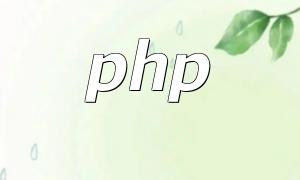Design patterns are proven solutions for recurring software development challenges. In PHP, applying design patterns helps developers create code that is more maintainable, scalable, and reusable. They serve as best practices for writing robust and elegant systems.
Design patterns are typically divided into three categories: creational, structural, and behavioral. Each focuses on solving specific types of design problems.
Creational patterns deal with object creation mechanisms, aiming to make systems independent of how their objects are created or composed. Common examples include:
Structural patterns focus on how classes and objects are composed to form larger structures while keeping flexibility and efficiency. Common examples include:
Behavioral patterns define how objects interact and distribute responsibilities among them. Common examples include:
The following example demonstrates the use of factory, proxy, and strategy patterns in a PHP shopping cart system.
interface DiscountServiceFactory {
public static function create(): DiscountService;
}
class NormalDiscountService implements DiscountService {
// ...
}
class PremiumDiscountService implements DiscountService {
// ...
}
class DiscountServiceFactoryImpl implements DiscountServiceFactory {
public static function create(): DiscountService {
if (isPremiumCustomer()) {
return new PremiumDiscountService();
}
return new NormalDiscountService();
}
}The factory pattern encapsulates the creation logic, allowing you to generate different discount service instances based on customer type without modifying client code.
class CartLoggerProxy extends Cart {
private $logger;
public function __construct(Cart $cart, Logger $logger) {
parent::__construct();
$this->cart = $cart;
$this->logger = $logger;
}
public function addItem(Item $item): void {
parent::addItem($item);
$this->logger->log("Added item to cart");
}
// Additional methods can be handled similarly
}The proxy pattern enhances an existing class by adding extra functionality, such as logging or access control, without changing the original implementation.
interface DiscountStrategy {
public function calculateDiscount(Cart $cart): float;
}
class NoDiscountStrategy implements DiscountStrategy {
public function calculateDiscount(Cart $cart): float {
return 0;
}
}
class FlatDiscountStrategy implements DiscountStrategy {
private $discount;
public function __construct(float $discount) {
$this->discount = $discount;
}
public function calculateDiscount(Cart $cart): float {
return $cart->getTotal() * $this->discount;
}
}
// Applying strategies
$context = new DiscountContext();
if (isPremiumCustomer()) {
$context->setStrategy(new PremiumDiscountStrategy());
} else {
$context->setStrategy(new NoDiscountStrategy());
}
$discount = $context->calculateDiscount();The strategy pattern allows dynamic selection of discount algorithms, making the system more flexible and easier to extend as new business rules emerge.
Design patterns are more than coding techniques—they represent structured approaches to problem-solving. By applying patterns such as factory, proxy, and strategy, PHP developers can build systems that are clean, adaptable, and easy to maintain. Mastering these patterns is a crucial step toward becoming a proficient PHP engineer.









